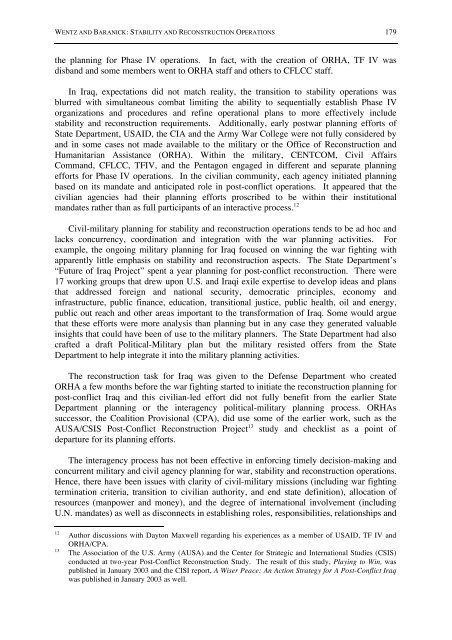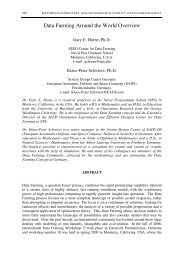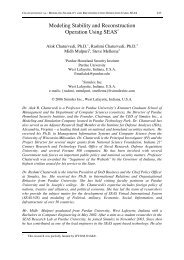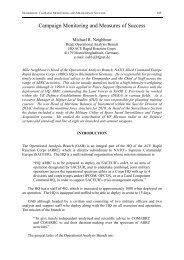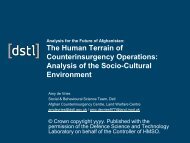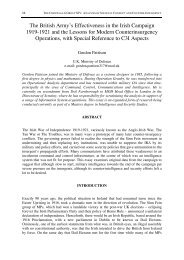Stability and Reconstruction Operations: What ... - Cornwallis Group
Stability and Reconstruction Operations: What ... - Cornwallis Group
Stability and Reconstruction Operations: What ... - Cornwallis Group
You also want an ePaper? Increase the reach of your titles
YUMPU automatically turns print PDFs into web optimized ePapers that Google loves.
WENTZ AND BARANICK: STABILITY AND RECONSTRUCTION OPERATIONS 179<br />
the planning for Phase IV operations. In fact, with the creation of ORHA, TF IV was<br />
disb<strong>and</strong> <strong>and</strong> some members went to ORHA staff <strong>and</strong> others to CFLCC staff.<br />
In Iraq, expectations did not match reality, the transition to stability operations was<br />
blurred with simultaneous combat limiting the ability to sequentially establish Phase IV<br />
organizations <strong>and</strong> procedures <strong>and</strong> refine operational plans to more effectively include<br />
stability <strong>and</strong> reconstruction requirements. Additionally, early postwar planning efforts of<br />
State Department, USAID, the CIA <strong>and</strong> the Army War College were not fully considered by<br />
<strong>and</strong> in some cases not made available to the military or the Office of <strong>Reconstruction</strong> <strong>and</strong><br />
Humanitarian Assistance (ORHA). Within the military, CENTCOM, Civil Affairs<br />
Comm<strong>and</strong>, CFLCC, TFIV, <strong>and</strong> the Pentagon engaged in different <strong>and</strong> separate planning<br />
efforts for Phase IV operations. In the civilian community, each agency initiated planning<br />
based on its m<strong>and</strong>ate <strong>and</strong> anticipated role in post-conflict operations. It appeared that the<br />
civilian agencies had their planning efforts proscribed to be within their institutional<br />
m<strong>and</strong>ates rather than as full participants of an interactive process. 12<br />
Civil-military planning for stability <strong>and</strong> reconstruction operations tends to be ad hoc <strong>and</strong><br />
lacks concurrency, coordination <strong>and</strong> integration with the war planning activities. For<br />
example, the ongoing military planning for Iraq focused on winning the war fighting with<br />
apparently little emphasis on stability <strong>and</strong> reconstruction aspects. The State Department’s<br />
“Future of Iraq Project” spent a year planning for post-conflict reconstruction. There were<br />
17 working groups that drew upon U.S. <strong>and</strong> Iraqi exile expertise to develop ideas <strong>and</strong> plans<br />
that addressed foreign <strong>and</strong> national security, democratic principles, economy <strong>and</strong><br />
infrastructure, public finance, education, transitional justice, public health, oil <strong>and</strong> energy,<br />
public out reach <strong>and</strong> other areas important to the transformation of Iraq. Some would argue<br />
that these efforts were more analysis than planning but in any case they generated valuable<br />
insights that could have been of use to the military planners. The State Department had also<br />
crafted a draft Political-Military plan but the military resisted offers from the State<br />
Department to help integrate it into the military planning activities.<br />
The reconstruction task for Iraq was given to the Defense Department who created<br />
ORHA a few months before the war fighting started to initiate the reconstruction planning for<br />
post-conflict Iraq <strong>and</strong> this civilian-led effort did not fully benefit from the earlier State<br />
Department planning or the interagency political-military planning process. ORHAs<br />
successor, the Coalition Provisional (CPA), did use some of the earlier work, such as the<br />
AUSA/CSIS Post-Conflict <strong>Reconstruction</strong> Project 13 study <strong>and</strong> checklist as a point of<br />
departure for its planning efforts.<br />
The interagency process has not been effective in enforcing timely decision-making <strong>and</strong><br />
concurrent military <strong>and</strong> civil agency planning for war, stability <strong>and</strong> reconstruction operations.<br />
Hence, there have been issues with clarity of civil-military missions (including war fighting<br />
termination criteria, transition to civilian authority, <strong>and</strong> end state definition), allocation of<br />
resources (manpower <strong>and</strong> money), <strong>and</strong> the degree of international involvement (including<br />
U.N. m<strong>and</strong>ates) as well as disconnects in establishing roles, responsibilities, relationships <strong>and</strong><br />
12<br />
13<br />
Author discussions with Dayton Maxwell regarding his experiences as a member of USAID, TF IV <strong>and</strong><br />
ORHA/CPA.<br />
The Association of the U.S. Army (AUSA) <strong>and</strong> the Center for Strategic <strong>and</strong> International Studies (CSIS)<br />
conducted at two-year Post-Conflict <strong>Reconstruction</strong> Study. The result of this study, Playing to Win, was<br />
published in January 2003 <strong>and</strong> the CISI report, A Wiser Peace: An Action Strategy for A Post-Conflict Iraq<br />
was published in January 2003 as well.


